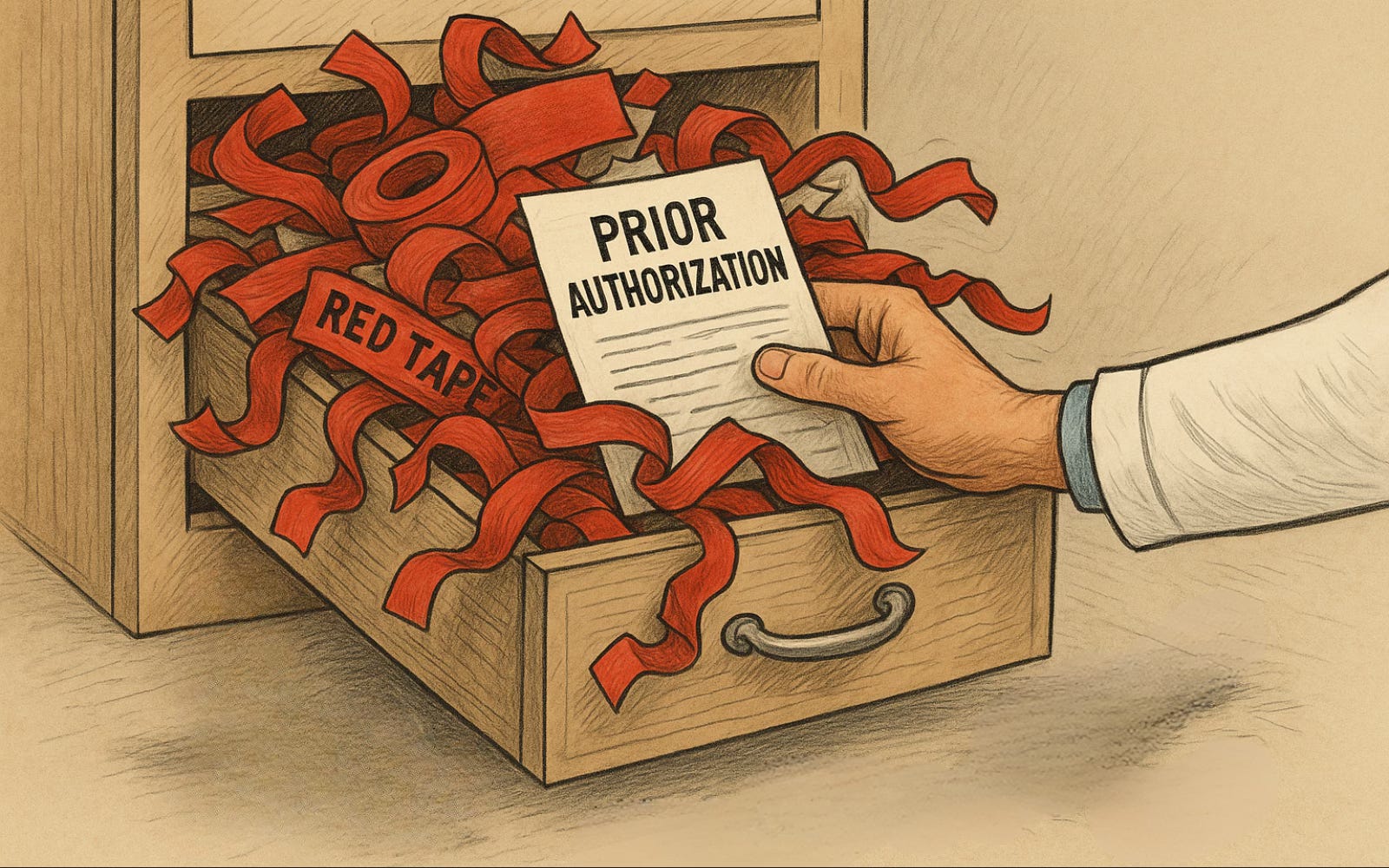Let’s Empty the Junk Drawer of Prior Authorization
What started as a simple tool to cut costs has exploded into a tangled mess of red tape – delaying care, wasting billions and leaving doctors and patients under piles of paperwork.
With some downtime last weekend, I finally tackled something my wife had been urging me to do for months – clean out the kitchen junk drawer. It was crammed full, and every time she tried to excavate its contents to find what she needed, I would cringe – a reaction followed inevitably by the sound of things crashing to the floor and a few choice expletives.
I sifted through an enormous pile and filled a trash bag with expired coupons, mystery gift cards, “winning” lottery tickets good for free replays, pills of unknown origin, and even my dad’s bottle of Colace from a recent visit. Buried in the chaos, I eventually unearthed a few essentials that actually belonged there: scissors, Scotch tape and a small flashlight.
Just like we use a junk drawer, health insurers initially used prior authorization (PA) as a practical tool. PA was meant to contain costs and ensure the appropriate use of care, but it has devolved into cluttered chaos, now so burdensome and misused that it no longer serves its original purpose. And instead of cleaning house, we keep piling on, because it’s easier and politically safer than doing the work to fix it.
Prior authorization (and utilization management more broadly) originated in 1973 with the Health Maintenance Organization Act, expanded with the Balanced Budget Act of 1997, and has since metastasized to encompass a dizzying range of drugs, imaging, lab tests and physician services. Cigna’s Medicare Advantage programs, like those of most insurers, now require prior authorization for nearly 4,000 services. In the Medicare Advantage program alone, over 50 million authorization requests are submitted annually. In contrast, traditional Medicare requires authorization for 52 procedures, most of which could be considered cosmetic. That’s because traditional Medicare was not built on a “managed care” chassis and consequently never adopted prior authorization as a tool that might theoretically save money; consequently, the administrative costs associated with traditional Medicare are much lower than in Medicare Advantage plans.
And what do we have to show for it?
Nominal health care spending has increased 50-fold, from about $100 billion in 1973 to more than $5 trillion in 2024. Health care now consumes 20% of our economy.
PA has failed to control costs, but it has been highly effective in three areas:
Driving record profits for insurers.
Generating massive administrative waste.
Inflicting real harm on patients and providers.
Last week, a colleague asked me to help a patient obtain life-saving cancer treatment her insurer had repeatedly denied. She was understandably distressed. As a former chief medical officer at a major insurer, it was clear to me this should have been approved expeditiously. I used my contacts, and by the end of the week, her treatment was approved – after a six-month delay. I can’t say for certain my intervention made the difference, but no one should need back channels to get critical care. Most patients simply don’t have the connections, resources or stamina to fight back – and many give up.
Clinicians are also being crushed.
They face daily disruptions: canceled appointments, postponed procedures and constant battles with insurers. The impact is everywhere:
89% say PA contributes to burnout
93% say it negatively affects clinical outcomes
94% report care delays
24% report serious patient harm, including hospitalization, permanent impairment or death
The waste is staggering. Hospitals and practices now hire entire teams just to manage prior authorizations. Duke Health employs nearly 400 people for this alone. A significant portion of the $1 trillion in U.S. administrative costs can be traced directly to PA.
If eliminating PA altogether feels radical, look abroad. Public systems like those in the U.K. and Canada rarely use PA. Private systems in countries like Germany and Australia, which are far less expensive than ours, use it sparingly and sensibly:
Germany reviews only a limited set of cases, using peer-to-peer review by clinicians in the same specialty.
Australia reserves PA mainly for high-cost drugs.
These systems rely instead on tools like global budgets, reference pricing and capitation to control costs effectively.
To be fair, there are leaders at the federal and state levels working to reduce the burden of PA, with recommendations that include requiring peer-to-peer conversations and streamlining PA processes and turnaround times. However, change is slow, fragmented and heavily reliant on technology infrastructure that doesn’t yet exist across many insurers, providers or in the Centers for Medicare and Medicaid Services.
But why settle for incremental fixes to a fundamentally broken system?
Instead, we need the courage to cut the Gordian knot. Congress should act to significantly curtail the use of prior authorization, limiting it to a narrow, evidence-based set of high-risk use cases. Insurers must also be required to rapidly adopt smarter cost-control methods – like gold-carding trusted clinicians – without compromising patient access or clinical autonomy.
It’s time to empty the junk drawer.
Then maybe clinicians will rediscover the tools they need to care for their patients.
Seth Glickman, MD, is a former insurance and health system senior executive. He now is a researcher and advocate for reform in the health care finance space.



As someone who studies the system’s design, I’ll say it plainly: prior authorization was never about care — it was about control. What started as “cost containment” has metastasized into a tool for delay, denial, and deterrence. When even physicians with insider knowledge have to fight behind the scenes, what chance do regular patients have? This isn’t just inefficiency — it’s engineered exhaustion. Time to empty the drawer and start over.
I agree that it is often a waste of time seeking preauthorization to see a specialist. These are hidden costs that delay timely care for patients.